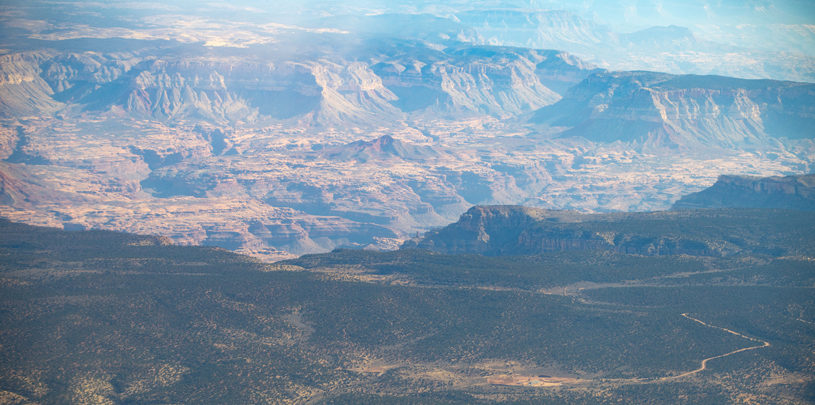
 by Amber Reimondo, Energy Director
by Amber Reimondo, Energy Director
In February, companies hoping to mine uranium near the Grand Canyon and elsewhere across the Colorado Plateau took another step closer to that goal. Uranium was included on a draft list of 35 minerals the Department of Interior now considers to be “critical.” As long as uranium is considered a critical mineral, it will be the policy of the federal government to identify new sources of domestic uranium, increase activity at all levels of the supply chain, “including exploration [and] mining,” and streamline leasing and permitting processes to expedite exploration, production, processing, reprocessing, recycling, and domestic refining of uranium.
The list was prepared in accordance with President Trump’s December 20, 2017 Executive Order 13817 aimed at identifying critical minerals and reducing U.S. imports of those minerals. To be sure, critical mineral lists are nothing new. In fact, the U.S. Geological Survey (USGS) has prepared them for years. It even published an updated list the day before President Trump signed this executive order, but that list didn’t include uranium.
A critical mineral, as defined in the executive order, is: “(i) a non-fuel mineral or mineral material essential to the economic and national security of the United States, (ii) the supply chain of which is vulnerable to disruption, and (iii) that serves an essential function in the manufacturing of a product, the absence of which would have significant consequences for the U.S. economy or national security.”
This particular list was made essentially to identify the non-fuel minerals or mineral materials that the federal government thinks should be made more accessible for mining on U.S. soil.
Ultimately, labeling uranium as a critical mineral provides more leverage for those seeking to overturn the Grand Canyon mining ban. Opponents of the ban have already tried to make the case to the Trump administration that the ban harms domestic energy development and economic growth. Now they’ll add that the ban burdens development of a critical mineral.
Already, the inclusion of uranium on Interior’s list of critical minerals is being used as a tool to promote enhancing access and streamlining permitting for uranium operations. The public has until March 18 to submit comments on the makeup of the Interior Department’s critical minerals list. Now is the time to voice your concerns about listing uranium as a “critical mineral” and what that will mean for uranium mining on public lands that surround the Grand Canyon.
1. Uranium is not a “non-fuel mineral or mineral material.”
Given the administration’s definition of a critical mineral as a “non-fuel mineral or mineral material,” it’s odd that uranium is on the list. That’s because, historically, uranium has been treated as a “fuel mineral.” The background document prepared by USGS to support the draft list even describes the value of uranium as lying in energy production. It’s not even on the U.S. Geological Survey’s current list of non-fuel minerals. “Mineral materials,” by definition, are things like sand, gravel, and rock and also don’t include uranium.
2. Access to uranium resources hardly needs “streamlining.”
The administration intends “to streamline permitting and review processes related to developing leases; enhancing access to critical mineral resources; and increasing discovery, production, and domestic refining of critical minerals.”
But the Mining Law of 1872, which governs uranium extraction, is perhaps one of the least restrictive regulations on the books. It was implemented 146 years ago, under President Ulysses S. Grant, in order to promote development of the American West. The law allows private mining companies, with questionable environmental oversight, to take billions of dollars of locatable minerals (including uranium) from public lands without paying a single cent in royalties to taxpayers. Federal agencies see the mining law as so permissive that, without the mining ban around the Grand Canyon (which withdrew the area from claims location under the Mining Law of 1872), regulators are likely — despite the known risks — to approve mining activities in the region.
And if we want to know what happens if the environmental regulations available today are stripped away, we need look no further than the Navajo Nation, where over 500 toxic, abandoned uranium mines still remain, impacting families and the environment. These mines are remnants of the 1950s Atomic Era — the last time the U.S. government propped up uranium mining, and for which the U.S. government is so far on the hook for nearly a billion dollars in liability.
Prefer snail mail? Send your comments to: Critical Minerals List, MS-1530, U.S. Department of the Interior, 1849 C Street NW, Washington, D.C. 20240 before the March 18 deadline.
A small victory in the legal case challenging Daneros uranium mine, near Bears Ears National Monument.
Read MoreGroundwater pumping at a uranium mine near the Grand Canyon will affect the canyon's springs, scientists says.
Read MoreA rally in Salt Lake City followed by a spiritual walk in White Mesa demonstrate the Ute community's determination to see uranium mill close.
Read More